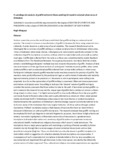Please use this identifier to cite or link to this item:
https://cris.library.msu.ac.zw//handle/11408/1688| Title: | A sociolinguistic analysis of graffiti written in Shona and English found in selected urban areas of Zimbabwe | Authors: | Mangeya, Hugh | Keywords: | Graffiti, Urban street protest graffiti, Social practice, Social construct, Sexuality, Socialisation, Urban public space, Naturalisation, Neutralisation, Interpellation | Issue Date: | 2014 | Publisher: | University of South Africa | Abstract: | Various researches across the world have established that graffiti writing is a universal social practice. The actual occurrence or manifestation of graffiti is however far from being universal cross-culturally. It varies based on a wide array of social variables. This research therefore set out to interrogate the occurrence of graffiti writing as a unique social practice in Zimbabwean urban areas. Three Zimbabwean urban areas (Harare, Chitungwiza and Gweru) were specifically sampled for the collection of graffiti inscriptions on various surfaces which included toilet walls, durawalls as well as road signs. Graffiti data collected from the various surfaces was complemented by reader feedback contributions from The Herald and Newsday. Focus group discussions provided a third tier of data aimed at establishing participants’ multiple reactions towards the practice of graffiti. Analysis of data was done based on three significant sections of participants’ attitudes towards graffiti, urban street protest graffiti as well as educational graffiti collected from various toilet surfaces in urban areas. Participants’ attitudes towards graffiti revealed varied reactions towards the practice of graffiti. The reactions were partly influenced by the participants’ ages as well as levels of education and maturity. Age and maturity proved to be predictors of the extent to which participants were willing to be pragmatic in so far as the appreciation of graffiti writing is concerned. Older and more experienced and mature participants were thus willing to look past the ‘deviant’ nature of graffiti writing to consider the various pressures that force writers to take to the wall. Urban street protest graffiti is a term coined in this research to capture the unique type of graffiti that is written on various surfaces along streets in urban areas. This highly textual graffiti is drastically different from the post-graffiti commonly found in Western urban cities and is aptly referred to as street art. Urban street protest mainly manifested itself in Zimbabwean urban areas in two main themes of protest inscriptions directed towards the operations of Zimbabwe’s electrical energy supplier (commonly referred to by its former name of the Zimbabwe Electricity Supply Authority - ZESA) as well as through political inscriptions. Political inscriptions expose a high degree of nuances that have not been hitherto discussed in literature on political graffiti inscriptions. The research analysed how graffiti writing can be employed for both pro-hegemonic and anti-hegemonic purposes. Inscriptions in high schools and tertiary institutions highlighted a differential construction of discourse on a gendered basis. Inscriptions in female toilets indicated a tendency of graffiti writers to perpetuate dominant educational, health, traditional and religious discourses which assert iii male dominance. The inscriptions show a major preoccupation with restricting or policing of female sexuality by fellow students mainly through the discursive usages of social corrective Shona labels such as hure (prostitute) and gaba ([big] tin). These are labels that are virtually absent in graffiti inscriptions in male toilets which is suggestive of a situation whereby female inscriptions are conservative. A consequence of such conservatism in inscriptions in female toilets is that no new sexualities are reconstructed and negotiated through discourses in discursive spaces provided by the inherently private nature of toilets in general. Thus, cultural and religious normative expectations are regarded as still weighing heavily on female high school writers in the construction and negotiation of sexuality and gendered behaviours, attitudes, norms and values through discourses constructed through graffiti. In contrast, male inscriptions highlight a major subversion of dominant discourses on abstinence and responsible sexual behaviours and attitudes. Corrective social labels such as ngochani (gay person) are mainly employed to pressure males into indulging and engaging in heterosexual behaviours. Discourses constructed through graffiti inscriptions in male toilets also demonstrate how sexuality is constructed through debate on the appropriateness of marginalised sexualities such as masturbation and homosexuality. | Description: | Submitted in accordance with the requirements for the degree of DOCTOR OF LITERATURE AND PHILOSOPHY in the subject of AFRICAN LANGUAGES at the UNIVERSITY OF SOUTH AFRICA | URI: | http://uir.unisa.ac.za/bitstream/handle/10500/18670/thesis_mangeya_h.pdf?sequence=4 http://hdl.handle.net/11408/1688 |
| Appears in Collections: | Thesis |
Files in This Item:
| File | Description | Size | Format | |
|---|---|---|---|---|
| Graffiti.pdf | 211 kB | Adobe PDF |  View/Open |
Page view(s)
92
checked on Feb 24, 2025
Download(s)
20
checked on Feb 24, 2025
Google ScholarTM
Check
Items in MSUIR are protected by copyright, with all rights reserved, unless otherwise indicated.



